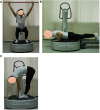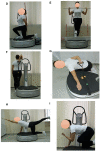Integrative function of proprioceptive system in the acute effects of whole body vibration on the movement performance in young adults
- PMID: 38654753
- PMCID: PMC11035735
- DOI: 10.3389/fspor.2024.1357199
Integrative function of proprioceptive system in the acute effects of whole body vibration on the movement performance in young adults
Abstract
Background: The proprioceptive system coordinates locomotion, but its role in short-term integration and recovery of motor activity in imbalance of motor patterns and body remains debated. The aim of this study is investigating the functional role of proprioceptive system in motor patterns and body balance in healthy young adults.
Methods: 70 participants (aged 20.1 ± 0.3) were divided into experimental groups EG1 (n = 30), EG2 (n = 30), control group (CG, n = 10). EG1 performed single WBV session on Power Plate (7 exercises adapted to Functional Movement Screen (FMS). EG2 performed single session of FMS Exercises (FMSE). CG didn't perform any physical activity. All participants performed pre- and post-session of FMS and stabilometric measurements.
Results: FMS total score in EG1 increased by 2.0 ± 0.2 (p0 < 0.001), this was significantly differed (p0 < 0.001) from EG2 and CG. Acute effects of WBV and FMSE on rate of change and standard deviation (SD) of pressure center (COP) were shown in all groups during Static Test (p0 < 0.01). SD increased (p0 < 0.01) in Given Setting Test in EG1 and EG2, and in Romberg Test (p0 < 0.001) in EG1. Length, width and area (p0 < 0.01) of confidence ellipse, containing 95% of the statokinesiogram points, decreased in Static Test in EG1; width and area (p0 < 0.01) decreased in EG2 group. Significant (p0 < 0.01) decrease in Given Setting Test was in EG1, and significant (p0 < 0.01) increase was in Romberg Test (open eyes) in CG. Maximum amplitude of COP oscillations: significantly (p0 < 0.01) decreasing along X and Y axes in EG1 and EG2, and along Y axis in CG during Static Test; along Y axis (p0 < 0.01) in all groups during Given Setting Test. Significant differences were identified (p0 < 0.01) in calculated energy consumption for COP moving during all stabilometric tests. However, inter-group differences in COP after acute WBV and FMSE sessions have not been identified.
Conclusions: Acute WBV session eliminates the deficits in motor patterns which is not the case after acute FMSE session, which, according to our integrative movement tuning hypothesis, is due to high activation of integrative function of proprioceptive system. Efficacy of WBV and FMSE on COP performance indicates a high sensitivity of postural control to different levels of proprioceptive system activity.
Keywords: acute FMSE; acute WBV; center of pressure; integrative proprioceptive system; motor patterns; postural control; young adults.
© 2024 Maslova, Shusharina, Videnin and Pyatin.
Conflict of interest statement
The authors declare that the research was conducted in the absence of any commercial or financial relationships that could be construed as a potential conflict of interest.
Figures






Similar articles
-
The Effects of Acute and Long-Term Whole-Body Vibration Training on the Postural Control During Cognitive Task in Patients With Chronic Ankle Instability.J Sport Rehabil. 2021 Jul 1;30(8):1121-1128. doi: 10.1123/jsr.2021-0034. J Sport Rehabil. 2021. PMID: 34214989 Clinical Trial.
-
Erratum.Mult Scler. 2016 Oct;22(12):NP9-NP11. doi: 10.1177/1352458515585718. Epub 2015 Jun 3. Mult Scler. 2016. PMID: 26041800
-
Effects of whole body vibration training on balance in adolescents with and without Down syndrome.Res Dev Disabil. 2013 Oct;34(10):3057-65. doi: 10.1016/j.ridd.2013.06.015. Epub 2013 Jul 19. Res Dev Disabil. 2013. PMID: 23872530 Clinical Trial.
-
Effects of an integrative warm-up method on the range of motion, core stability, and quality of squat performance of young adults.Front Sports Act Living. 2024 Mar 27;6:1323515. doi: 10.3389/fspor.2024.1323515. eCollection 2024. Front Sports Act Living. 2024. PMID: 38600903 Free PMC article.
-
Neuromuscular response to a single session of whole-body vibration in children with cerebral palsy: A pilot study.Clin Biomech (Bristol). 2020 Dec;80:105170. doi: 10.1016/j.clinbiomech.2020.105170. Epub 2020 Sep 5. Clin Biomech (Bristol). 2020. PMID: 32920250
Cited by
-
Acute Effects of a Single Whole-Body Vibration Session on Mobility and Postural Control in Community-Dwelling Older Adults: A Randomized Clinical Trial.J Funct Morphol Kinesiol. 2025 Feb 24;10(1):75. doi: 10.3390/jfmk10010075. J Funct Morphol Kinesiol. 2025. PMID: 40137327 Free PMC article.
References
LinkOut - more resources
Full Text Sources
Miscellaneous

